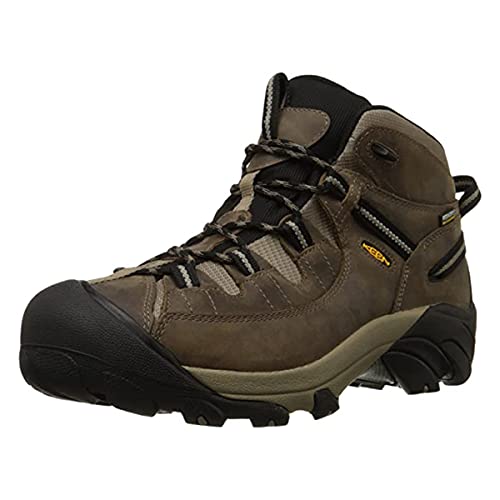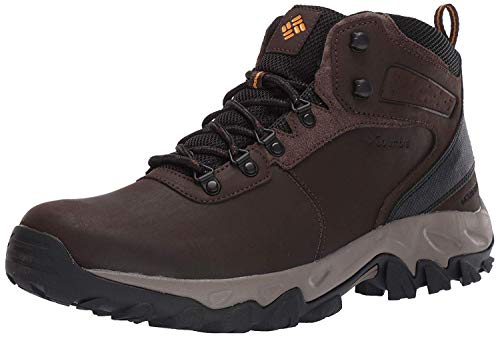Choosing the right hiking boots can be the difference between the hike of a lifetime or a blister-filled damp disaster. Is water-resistant good enough or should you go for something waterproof? And is it possible to find a durable boot within a reasonable budget?
We’ve taken on these questions so you don’t have to. Read on to discover the best hiking boots for a budget of $100. Whether you are heading to Alaska or to your local national park, you should be able to find a boot to suit your needs. Take a look at our top picks below.
Best Hiking Boots under $100 For Women
5. Mishansha Mens Womens Winter Ankle Snow Hiking Boots
The unisex Mishansha ankle hiking boots are excellent value for money. They are comfortable, warm, water-resistant and retail at under $50. They give some support but are not designed to withstand more than six to eight hours of hiking, nor are they appropriate for extreme weather.
As an amateur hiking boot, however, they are surprisingly comfortable for a budget product. They also have the added feature of a toe cap, enhanced with TPR material to protect feet from low impact knocks and bumps.
4. Timberland Women’s White Ledge Mid Ankle Boot
These leather hiking boots from Timberland start from well below $100. They utilize shock-absorbing cushioning and they are completely waterproof. This means that you can trust your feet will be protected from wet conditions and trail obstacles.
Timberland products are notoriously high quality and the White Ledge Mid Ankle Boot is no different. These boots are exceptionally durable and are designed to be easily worn in, so you can avoid blisters even on a long hike.
3. Merrell Women’s Moab 2 Vent Mid Hiking Boot
There’s a reason that Merrel’s hiking boots receive unanimous praise and it comes down to the comfort factor. The Moab 2 Vent Boots are lined with breathable mesh so that your foot to reduce sweat and avoid blisters. The closed-cell foam tongue helps to keep the moisture out, along with any random debris that may be floating about your trail.
The specially designed contoured footbed offers extra support for the arch and heel. The only downside is that these boots are not waterproof but even so, they dry out very quickly if they do get damp.
2. XPETI Women’s Thermator Mid High-Top Waterproof Hiking Outdoor Boot
The XPETI Thermator hiking boots are ideal for all types of hiking. They are highly durable and are designed to withstand all types of environments, be it wet mud, snow, or uneven terrain. The boots contain Thinsulate insulation which will keep feet warm in temperatures as low as -25C.
Additional features include a rubber toe cap and molding TPU on the heel to protect feet from impact or slips. When it comes to hiking in tough conditions, these are the boots you want. They are very comfortable too.
1. Columbia Women’s Newton Ridge Plus Waterproof Hiking Boot
The top product when it comes to affordable women’s hiking boots is the Columbia Newton Ridge Plus Waterproof Boot. These shoes are made from high-quality materials and tick all the boxes when it comes to finding reliable hiking footwear.
As a brand, Columbia utilizes unique technology to ensure maximum protection from slipping and environmental impact. What’s more, the boots are lightweight so they can be comfortably packed on vacation. They are also quite stylish and are available in a range of colors.
Ultimately though, it’s the impact absorption and thick cushioning that places Columbia in a league of their own when it comes to comfortable and durable footwear.
Best Hiking Boots under $100 For Men
5. NORTIV 8 Men’s Waterproof Snow Winter Hiking Boots
Considering their high quality, the Nortiv 8 boots are surprisingly affordable. These boots are designed for outdoor hikes and promise to keep your feet dry all day. The durable rubber outsole means the boots are equipped to take on all kinds of terrain.
That said, they won’t stand up to longer hikes, but for a standard pair of hiking boots, they do the trick. They are also suitable for snowy conditions.
4. KEEN Men’s Targhee II Mid Waterproof Hiking Boot
Keen’s Targhee II hiking boots offer maximum comfort. In fact, the thick padding and breathable leather mean these boots don’t require much breaking in. They fit snugly and so we recommend buying the boots ½ a size up from your standard shoes.
The outsole is tough and will bite into the roughest of terrains. The support is enhanced to prevent you from going over on your ankle and ‘100% waterproof’ is no exaggeration. These are boots you can trust in.
3. Columbia Men’s Newton Ridge Plus II Waterproof Hiking Boot
When it comes to versatility, the Columbia Men’s Newton Ridge Plus II is one of the best going. Columbia uses Omno-GRIP non-marking traction rubber for the outsoles which means high grip is guaranteed across a wide variety of terrains, no matter the season.
The lightweight midsole is not only practical for packing but the cushioning provides extra comfort for long hikes. These are boots you can trust when embarking on an eight-hour volcano hike in rainy conditions. It’s what they are designed for.
2. Columbia Men’s Newton Ridge Plus Ii Suede Waterproof Boot
The Newton Ridge Plus II hiking boots are also available in suede. If you are in need of waterproof footwear, you can trust that these boots will keep your feet dry in the deepest of puddles. They dry out quickly and are reliable even in severe snowy conditions.
Furthermore, they boast all the same great features as the previous listing. This includes maximum comfort and Colombia’s signature Omno-GRIP non-marking traction rubber outsoles. Although the boots are designed to fit comfortably on all, they are particularly popular among those with narrow feet.
1. Timberland Men’s White Ledge Mid Waterproof Ankle Boot
The top choice for men’s hiking boots is the Timberland Wide Ledge Waterproof Ankle Boots. They are perfect for hikers who take on 500-700 miles per year and are used to tackling snowy conditions.
They are easy to break in, keep feet toasty warm and they are designed to fit snugly without limiting circulation. The uppers are made from 100% waterproof leather so no damp will sneak in. The solid rubber outsole comprises of multi-directional lugs to ensure that whatever terrain is tackled, the grip will be up to the job.
There are a range of options available should you wish to add extras, but when it comes to finding hiking boots for all conditions under $100, these Timberlands come out on top.
Hiking Boots Buyers Guide
When choosing the right hiking boots for you, the first thing to consider is what you intend to be using them for. If your typical hike route is a 3-hour hike around country roads, you are going to need a very different boot to someone who is trekking in snowy Scandinavian conditions.
When considering whether to fork out on extras like waterproof material, it’s important to be honest with yourself about whether these features are really necessary for the kind of hikes you plan on doing.
Above all, the secret to choosing the right hiking boots is choosing a pair that fit you properly. Hiking boots should fit snugly and offer just enough wiggle room where your toes are.
Before you test your boots on a length hike, test them out by wearing them with your hiking socks. It’s best to try them at the end of the day as this is when your feet are most swollen.
If you have found a pair that ticks all your boxes but this fit isn’t quite right, consider insoles before abandoning the product completely. Changing how you tie your laces can also affect how they fit.
Other factors to consider include the quality of the outsoles and the material used for the midsoles. If you are hiking on uneven terrain, you will need an outsole with decent traction.
Look for boots with multi-directional lugs (that’s the bits on the sole that do the gripping) and check they are made from durable rubber. For the midsoles, you ideally want something made from EVA or polyethylene. The former is lighter while the later is better for longer, more intense hikes.
FAQ
Is there a difference between water-resistant and waterproof?
If boots are water-resistant, they will protect your feet from damp and moisture, as long as you do not fully submerge your feet in water. These boots should be sufficient for hiking trails in moderate conditions.
If you are heading somewhere wetter, waterproof boots will give your feet full protection from the elements. For a boot to be fully waterproof, it must fit snugly and have a waterproof tongue.
Which boots are most suitable for uneven terrain?
If you are hiking on routes with uneven terrain, you want boots with a decent grip. Most hiking boots will have rubber soles but for maximum traction, choose soles with deep and dense, multi-directional lugs.
If you are worried about going over on your ankle, choose a boot with ankle support rather than an ankle boot.
Which is the best material for hiking boots?
Leather is usually a good choice for hiking boots as it is durable, water-resistant, and high quality. For a vegan option, synthetic leather boots made from polyester or nylon are a budget-friendly option. They may not be as durable, but they break in more quickly and will cost you less in the short term.
How can I avoid blisters?
The key to avoiding blisters is to make sure your boots fit snugly with a little wiggle room around the toes. Choosing breathable midsoles will reduce sweating which will, in turn, reduce rubbing and prevent blisters.
At the end of the day, if you choose a high-quality hiking boot that fits you well, blisters should not be a problem you are contending with. Be sure to also wear appropriate socks.
What is a heel brake and do I need one?
A heel brake is the defined heel zone between the forefoot and the arch. If you are tackling uneven terrains, a heel brake will reduce your chances of slipping or sliding. They are not necessary for less challenging hikes.


















Leave a Reply